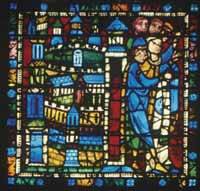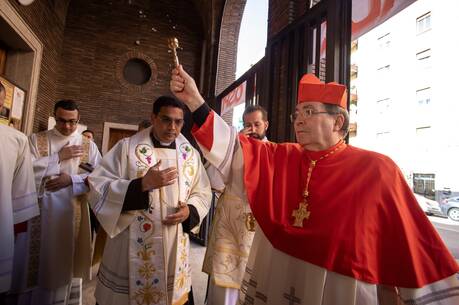Whatever Chartres may be now,” wrote Henry Adams, “when young it was a smile.... To us it is a child’s fancy, a toy-house to please the Queen of Heaven—to please her so much she would be happy in it—to charm her till she smiled.” The cathedral of Notre Dame de Chartres is the crown of Gothic art and architecture. More than five decades ago, Mary’s smile beguiled Malcolm Miller, a native of Britain. Ever since, he has made his home in her sight and guided pilgrims, students and tourists through the treasures of her home. A distinguished interpreter of the Cathedral of Our Lady of the Assumption of Chartres, Mr. Miller is a chevalier of the Ordre National de Mérite and chevalier of the Ordre des Arts et des Lettres. Among the guidebooks he has written, Chartres Cathedral (1985, 1996) is perhaps the best known. When I visited Chartres last summer, Mr. Miller agreed to this interview for America.
I remember that moment: the afternoon of July 19, 1968. After nearly seven months in an English hospital and six operations, I took a train from Paris back to Chartres; I saw the cathedral and wept. I knew that this is where I should spend the rest of my life.
My attachment to Chartres, however, had begun 12 years earlier. For a degree in French from Durham University, I was required to spend an academic year in France teaching English in a high school and writing a mini-thesis. I wrote about Chartres Cathedral. After graduating, I took teaching appointments in Pau, Marseille, Toulon and Paris, but returned to Chartres each Easter and summer vacation to be a guide at the cathedral. My former students and their families then became my friends. One was the son of the state-employed architect responsible for the cathedral, which, like most other French cathedrals, has been state-owned since the French Revolution. He and the clergy authorized me as a guide in 1958, but I had no idea then that it would become my life’s work.
Could you sketch the history of the cathedral’s development?
The present early 13th-century cathedral stands on a Roman site. Chronicles mention the destruction of a Chartres Cathedral by Hunald, Duke of Aquitaine, in 743, but this was not likely the first Chartres cathedral. The second recorded Chartres Cathedral is known to have been dedicated to the Virgin Mary, because a text mentions that Charlemagne’s father, Pippin the Short, King of the Western Franks, sent gifts to the “Church of Our Lady at Chartres.” (Paris Cathedral at that time was dedicated to St. Stephen.) Vikings pillaged and burned the city and its cathedral in 858, and a new cathedral was built quickly. Probably for its dedication (again to Mary) in 876, Charles the Bald presented a famous relic, the Sancta Camisia, supposedly worn by Mary when she gave birth to Jesus. Later, as the cult of the Virgin Mary developed in the Western church, the relic turned Chartres Cathedral into one of the great pilgrimage shrines of Europe, and Mary became “Queen of All the Saints.”
One of the people responsible for the cult of the Virgin was St. Fulbert, who came to Chartres around 990 to teach in the cathedral school, one of the most illustrious in Europe. In 1006 Fulbert was enthroned as bishop of Chartres. After a fire in 1020, he commissioned the construction of a much larger Romanesque edifice to accommodate the growing number of pilgrims. When Fulbert’s building was severely damaged in another fire in 1194, only the crypts, the two mid-12th-century western towers (with the steeple of the one to the south), and the Royal Portal survived. This determined both the width and length of the present Gothic cathedral, in that the only possible expansions were upward and the addition of a transept. The extra height was made possible with flying buttresses, which enabled the master masons to open the walls to let in more light and to be filled with stained-glass windows.
Donations for rebuilding came from kings and queens in France, Spain and England; a duke of Brittany paid for a rose window, and other windows have the heraldry of aristocratic families, such as Montfort, Beaumont, Courtenay and Clément. Craftsmen and the merchant brotherhoods financed another 42 windows. The finest masons, sculptors, carpenters, smiths and stained-glass window makers were brought to the site.
Today Chartres Cathedral is the best preserved of Europe’s Gothic cathedrals, with most of its original stained glass and sculpture still intact.
How are the architecture, statuary and windows of the cathedral interrelated?
When lecturing on Chartres Cathedral, I liken it to a modern public library, except that its texts are written in the stained glass and sculpture of the 12th and 13th centuries. Printing had not yet been invented; paper did not exist in Europe. Most of the population could not read or write, but people knew how to “read” a window. The lives of the saints were well known, and the educated could understand the more complex symbolic interpretations of the biblical texts.
Another comparison is that Chartres Cathedral is a great book we can still read in the 21st century. Its architecture is the metaphorical binding; its text is that of linear, eschatological time from the creation to the Day of Judgment, with God incarnate, Jesus, in the middle of time (as redeemer) and at the end of time (as judge). In medieval times the Old Testament was considered a prefiguration of the New. Saint Augustine wrote: “The Old Testament is the New Testament veiled. The New Testament is the Old Testament unveiled.”
There are said to be 176 images of Mary in the cathedral. Can you discuss the range of styles represented?
The number comes from a book written in 1926 by Canon Yves Delaporte, the diocesan archivist. Mary is omnipresent because of the relic and because Chartres Cathedral is dedicated to her Assumption.
Mary is represented as a child with her parents, Anne and Joachim, in both the 12th- and 13th-century stained glass and sculpture, and in the 16th-century Renaissance choir screen. As Theotokos (God-bearer), Mary is the instrument of the Incarnation and is represented in the nativity scenes as well as in the Jesse Tree window. Her death (dormition) and assumption are narrated in both 13th-century glass and sculpture. Mary is also sculpted on the central tympanum of both the north porch, crowned by her Son as Queen of Heaven, and the south porch, as the principal intercessor for humanity on the Day of Judgment.
As elsewhere in medieval iconography, Mary is represented as the Seat of Wisdom, the Throne of Solomon and Notre-Dame de la Belle Verrière (Our Lady of the Beautiful Window)—in stained glass, in the crypt and in a wooden carving.
Do the student pilgrimages that began with the French poet Charles Péguy (1873-1914) continue today?
Yes, the student pilgrimage still exists, although the number of pilgrims has decreased. But the number of tourists has increased dramatically since I began guiding in 1958.
Have aspects of the church grown more important for you over the years?
Especially exciting for me is the restoration of both the sculpture and the stained glass. Traces of medieval paint can now be seen on the sculpture of the north porch. The cleaning of the south porch sculpture, using laser equipment, will begin in 2009.
Restoration of the stained glass began in 1974, and all the lower windows now sparkle. Work has begun (cleaning, releading, double glazing) on the clerestory windows in the choir, and the difference is amazing.
Medieval texts speak of cathedrals as an earthly symbol of God’s city, the Heavenly Jerusalem, its walls “garnished with all manner of precious stones” (Rv 21:19).








